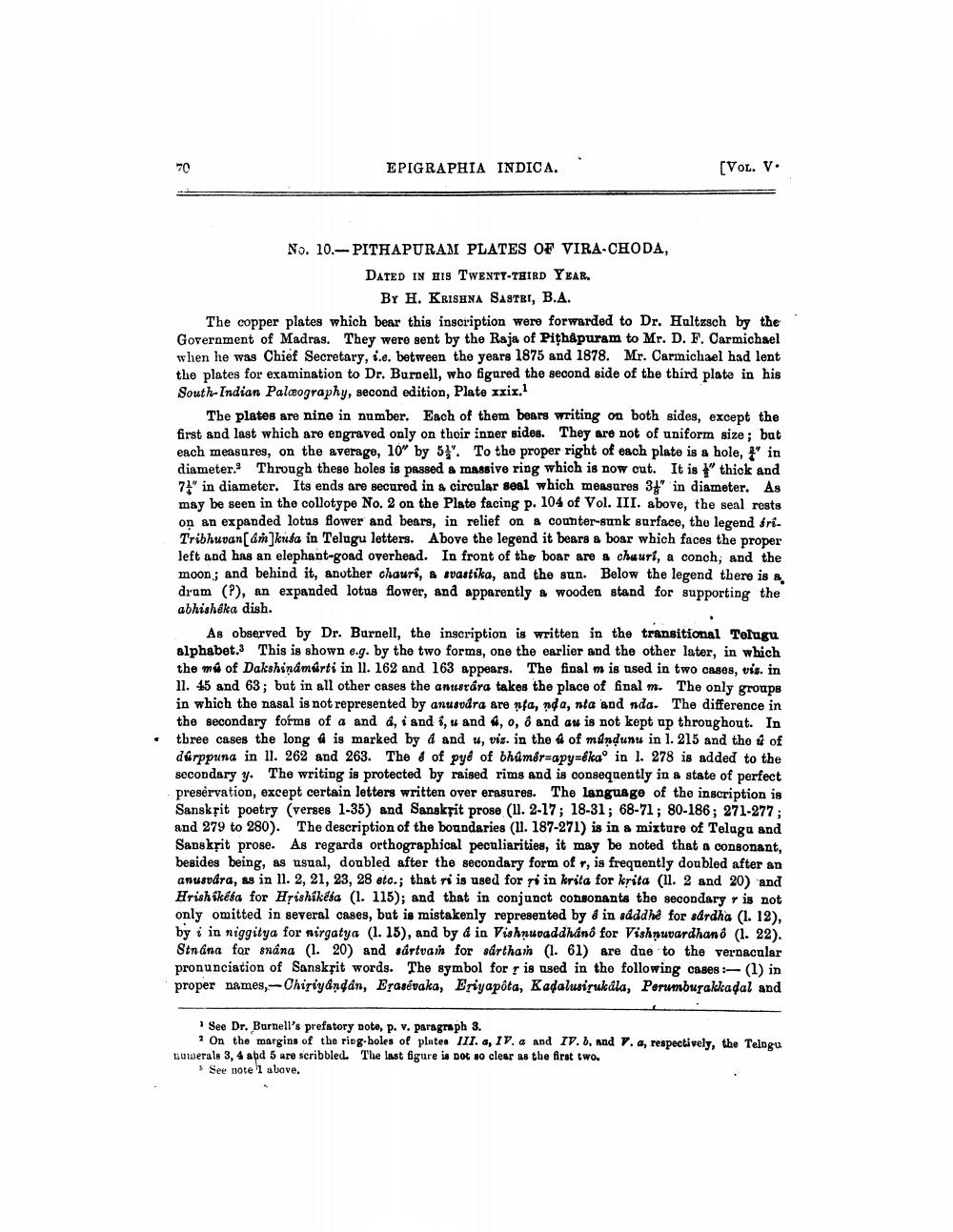________________
EPIGRAPHIA INDICA.
(VOL. V.
No. 10.- PITHAPURAM PLATES OF VIRA-CHODA,
DATED IN HIS TWENTY-THIRD YEAR.
BY H. Krishna Saster, B.A. The copper plates which bear this inscription were forwarded to Dr. Hultzsch by the Government of Madras. They were sent by the Raja of Pithapuram to Mr. D. F. Carmichael then he was Chief Secretary, i.e. between the years 1875 and 1878. Mr. Carmichael had lent the plates for examination to Dr. Burnell, who figured the second side of the third plate in his South-Indian Palæography, second edition, Plate xxix.
The plates are nine in number. Each of them bears writing on both sides, except the first and last which are engraved only on their inner sides. They are not of uniform size; but each measures, on the average, 10" by 5%. To the proper right of each plate is a hole, *" in diameter. Through these holes is passed a massive ring which is now cut. It is thick and 71" in diameter. Its ends are secured in a circular seal which measures 3*" in diameter. As may be seen in the collotype No. 2 on the Plate facing p. 104 of Vol. III. above, the seal rests on an expanded lotus flower and bears, in relief on a counter-sunk surface, the legend friTribhuvan[am]kufa in Telugu letters. Above the legend it bears a boar which faces the proper left and has an elephant-goad overhead. In front of the boar are a chuuri, a conch, and the moon; and behind it, another chauri, & svastika, and the sun. Below the legend there is a drum (?), an expanded lotus flower, and apparently & wooden stand for supporting the abhisheka dish.
As observed by Dr. Burnell, the inscription is written in the transitional Telugu alphabet. This is shown e.g. by the two forms, one the earlier and the other later, in which the mø of Dakshinamárti in 11. 162 and 163 appears. The final m is used in two cases, vis. in 11. 45 and 63; but in all other cases the anustára takes the place of final m. The only groups in which the nasal is not represented by anusudra are nta, nda, nta and nda. The difference in the secondary forms of a and d, i and 6, 4 and 4, 0, ô and au is not kept up throughout. In three cases the long 6 is marked by d and u, viz. in the of mindunu in l. 215 and the t of dørppuna in 11. 262 and 263. The & of pyé of bhúmor=apy=&kao in l. 278 is added to the secondary y. The writing is protected by raised rims and is consequently in a state of perfect preservation, except certain letters written over erasures. The language of the inscription is Sanskřit poetry (verses 1-35) and Sanskrit prose (11. 2-17; 18-31; 68-71, 80-186; 271-277; and 279 to 280). The description of the boundaries (11. 187-271) is in a mixture of Telugu and Sanskrit prose. As regards orthographical peculiarities, it may be noted that a consonant, besides being, as usual, doubled after the secondary form of r, is frequently doubled after an anusvdra, as in 11. 2, 21, 23, 28 etc.; that ri is used for ri in krita for krita (11. 2 and 20) and Hrishikesa for Hrishiketa (1. 115); and that in conjunct consonants the secondary r is not only omitted in several cases, but is mistakenly represented by & in adddhe for sdrdha (1. 12), by i in niggitya for nirgatya (1. 15), and by & in Vishnuvaddhánô for Vishnuvardhanó (1. 22). Stn ana for snána (1. 20) and sártvam for sárthan (1. 61) are due to the vernacular pronunciation of Sanskrit words. The symbol for p is used in the following cases :-(1) in proper names, --Chiriyandan, Erasevaka, Eriyapôta, Kadalusisukdla, Perumburakkadal and
See Dr. Burnell's prefatory pote, p. v. paragraph 3.
? On the margins of the ring-boles of plutes III.a, IV. a and IV. 6. And 7. a, respectively, the Telngu towerals 3, 4 apd 5 are scribbled. The last figure is not so clear as the first two.
See note 1 above.




